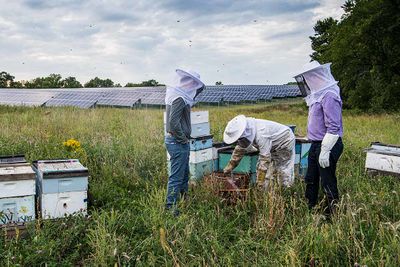InSPIRE/low impact/agricultural/agricultural activities
Low-Impact Solar Development Strategies Guidebook
Suitable Agricultural Activities for Low-Impact Solar Development
A wide variety of agricultural activities are suitable for integration with solar installations. Agriculture co-location can include growing crops, grazing livestock, supporting pollinator habitat, as well as hosting apiaries.
The success of the agricultural activity will be determined by local conditions as well as management practices. In general, most agricultural activities that are possible in a specific region will also be possible in an agriculture co-location context. Certain exceptions include large-scale agricultural activities that require massive equipment (e.g., corn, soybeans), crops that grow extremely tall, or incompatible livestock (e.g., goats, bison).

NREL researcher Jordan Macknick works with teams from University of Massachusetts (UMass) Clean Energy Extension and Hyperion on a photovoltaic dual-use research project. Photo from NREL Image Gallery

Student researchers plant vegetable crops underneath solar arrays. Photo by Greg Barron-Gafford
Agricultural crops can thrive underneath the partial shade conditions of solar installations. Crops that are successful in a particular region are likely suitable in a co-location context. Crops can be grown directly underneath panels, in between rows of panels, and outside the perimeter of the solar installation. The partial shade conditions of solar installations can lead to changes in performance and maintenance. Some specific differences are highlighted below.
Sunlight The partial shade will likely reduce the amount of direct sunlight reaching the crops, while also changing microclimate and hydrological conditions.
Microclimate Below the panels the crops are likely to be cooler during the day, but warmer at night. This has the impact of reducing heat stress as well as reducing risks of frost damage. It can also extend growing seasons in multiple regions. Humidity and wind patterns are also likely to change.
Soil Moisture Conditions underneath the panels also will likely increase soil moisture levels, which can lead to a reduction in irrigation needs. This can lead to a challenge in wetlands or other extremely wet environments, if too much water is already a concern for agricultural crops.
Research is still ongoing to best understand the relative performance of crops in agriculture-solar co-location configurations compared with those in the open-air. In general, results indicate that there can be both benefits and tradeoffs of co-location, depending on crop selection and specific location. In some arid environments, for example, research highlights substantially higher yields with lower water requirements for many crops, indicating great successes. In more temperate environments, results are more nuanced, with panel spacing and specific summer conditions playing an important role in determining eventual yields and impacts.

Sheep graze at solar site. Photo by Rob Davis / Fresh Energy
Livestock can effectively manage vegetation underneath solar arrays, and can provide multiple benefits to solar providers and grazing entities. Sheep grazing can reduce mowing and herbicide use and provide another revenue stream for herders. Those with experience in this area report greater success when forage needs are taken into consideration in the design phase and determining the re-seeding mix. If a solar operator is considering using sheep grazing for vegetation management then modules, wires, and electrical boxes should be raised to prevent possible damage to equipment. Sheep that are raised for meat are often preferred as they tend to be more docile than those raised for wool production. Often a herder will require access to a water source on a solar site that needs to be provided by the operator. Insurance companies are comfortable insuring solar farms that use sheep for grazing as they have been used on numerous solar sites in the U.S. and in Europe.
Sheep can also be beneficial when coupled with native plant establishment, but timing of sheep grazing will need to be accounted for. Sheep can reduce weed cover and allow native vegetation to take over after sheep hooves bring up latent seeds. However, care should be taken to prevent the sheep from eating vulnerable, smaller native species. Also, if pollinator friendly habitat is being cultivated care around flowering schedules and sheep grazing should be exercised to allow for pollinators to take advantage of the flowering habitat.
Other animals have been proposed for grazing, such as cows, bison, and goats. Cows and bison are generally not preferred due to their large weight, tall height, and tendencies to rub up against and damage equipment. Goats are not preferred as they are likely to chew on electrical wires and jump up on modules, possibly damaging modules and leading to shading.
Other vegetation can be grown underneath and around solar installations that can benefit local agriculture. Specifically, growing native vegetation and/or pollinator habitat can provide multiple benefits to soil quality and agricultural yields. Growing native vegetation and pollinator habitat can help improve soils by retaining and building valuable nutrients, improving water infiltration, and reducing erosion. Pollinator habitat can improve local agricultural yields by providing habitat and forage for beneficial insects that can assist nearby farms.

Beekeeper inspects hives near a pollinator friendly PV array site. Photo from NREL Image Gallery
When growing pollinator-friendly vegetation underneath solar arrays, apiaries can often be a suitable accompanying agricultural activity. Pollinator-friendly solar arrays can provide forage for honeybees as well as serve as a wind block, when apiaries are located alongside solar installations. Apiaries can be both within or outside of the specific project perimeter; honeybees have a range extending a few miles, and are likely to visit multiple sites each day.
To learn about more best practices, see the Low-Impact Solar Development Strategies Guidebook.